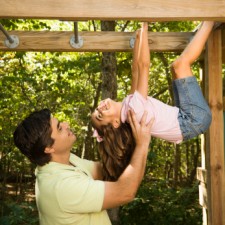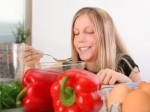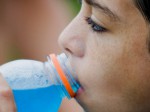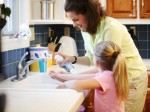 Children are getting fatter at a younger age. Around 21% of New Zealand children aged 2-14yrs are overweight and 10% are obese. Obesity is higher in Pacific (23%) and Maori (17%) and children living in deprived areas (19%).1
Children are getting fatter at a younger age. Around 21% of New Zealand children aged 2-14yrs are overweight and 10% are obese. Obesity is higher in Pacific (23%) and Maori (17%) and children living in deprived areas (19%).1
Concern is now being expressed that overweight mothers are giving birth to children with early signs of narrowing of their arteries.2 Research is also showing that children who are overweight at 4yrs become overweight adults with an increased risk of developing diabetes, heart disease and high blood pressure as they get older.3
To turn these statistics around we need to focus on children’s diet* and exercise. That doesn’t mean that we need to consider dieting our children or dragging our toddlers around the race track but we do need to look at some simple things we can do to get healthier together.
Value Playtime
Most people assume that children get enough physical activity at school and when they play. However there is increasing evidence that children’s lives are becoming more sedentary.4 Children spend a significant proportion (55%) of their leisure-time on ‘electronic entertainment’ including television, video and using computers. The number of children walking or cycling to school has also declined in recent years as busy parents, often concerned with safety issues in the community, prefer to drop children at the school gate as they drive to work.
Encouraging primary school children to become more involved in extra curricular time at school and leisure time can help to slow unhealthy weight gain.5 In order to make play activities appealing to children and parents we need to:
Make it fun!
Recent research by AUT Associate Professor Erica Hinckson looking at children aged 8-12ys and their parent’s perception of play verses physical activity found that:
–Physical activity– was considered to be “good for you” and needed to be structured in order to be beneficial. It needed to take place at a specific time and was therefore “a chore”.
– Play , on the other hand, was considered to be more spontaneous, unstructured activities that “were fun”. 6
Make it age appropriate
A child’s ability to engage in exercise is determined by their physical, mental and social development.7 Understanding how their child’s movement develops can help parents to encourage suitable play activities as the child grows. This approach will not only strengthen their physical development but also, over time, help children to develop their confidence and self-esteem.
-Infancy: Movement is rhythmic and corresponds to the development of motor skills, hand and eye co-ordination. So encouraging an infant to kick or crawl around a play pen (supervised) would be preferable to leaving a child to sit in a car seat or bouncer for long periods of time.
–Pre-school: Exercise comes in the form of play as strength and endurance develops along with cognitive development aiding concentration and tactical play.
–Middle Childhood: Rough and tumble play begins to develop a social component as children interact and start to take part in team sports and group activities at school. (See ideas for activities below).
Encourage play within the community
In the AUT study of children’s activity, parents felt that children would become more active if there were safer communities; where children had more places to play; supervised playgrounds; more time, money and transport was available through such things as car pooling to take children to activities such as swimming, along with better community communication and support.5
Push parents to play
Encouraging parents to become more active themselves reinforces the message to children that exercise should be valued.
In 2003 the Cancer society and SPARC undertook The Obstacles to Action (OTA) research of 8000 New Zealanders looked at some of the barriers and motivating issues relating to parental exercise.8
Barriers to parental exercise Motivators
Lack of time and energy If activity was good for “own health”
Lack of encouragement If activity kept them “in shape”
Lack of family support If encouragement was given
If they had poor health themselves Wanted to be a good role model for their kids
The Push Play campaigns that followed the OTA research has endeavoured to inspire New Zealanders to fit sport and recreation into their busy day. Annual themes 2005-9
- “Snack on exercise” every bit counts towards 30-60 minutes of exercise/day.
- Make exercise” a habit”.
- “Parents push play”- children needed 60 minutes of moderate intensity exercise per day and adults at least 30 minutes
- “Feel great” encouraged people to push themselves to conquer goals such as finishing a run; pushing uphill on a bike; hitting the perfect shot at golf etc.
These campaigns are very important because studies looking at role modelling have found that:
- Children, particularly young children 4-7 yrs and 9-15 yrs will become more active if their parents are active.9
- A father’s activity in particular has the biggest impact on his children’s level of activity.10
The Role of Schools
Over the past twenty years there have been huge changes within the school curriculum
Physical activity is not the same as physical education (PE) although parents often confuse the two.
- Physical activity refers to behaviours consisting of bodily movement that require energy expenditure and a greater than normal physiological engagement of muscles and cardio vascular function.
- PE is a written curriculum that normally follows national standards which may cover teaching skills of different sports but could also focus on sedentary topics such as nutrition; relationships; rules of games, history of sports etc.
As children advance through their school years of PE they are encouraged to take part in a wide variety of sporting endeavours. However parents can also help by encouraging their children to play and be more active when at home.
Play activities
Here are some ways to keep children moving with activities that parents might also like to take part in:
|
5-9 yrs |
10-12 yrs. |
13-18 yrs |
| Join parents after school | Buy gifts for active play such as | Join sports clubs/associations |
| for- backyard cricket, soccer | hacky sacs, tennis rackets, | Bike to work and school |
| touch rugby or four square | cricket bats, skates, basket ball | Walk with a friend |
| Make obstacle courses at home | Join a club e.g. scouts, guides | Set personal goals e.g. 10km |
| Walking bus groups to school | YMCA | walk, jog non stop 10-30min |
| Cycling groups | Bush walking or tramping at | Make school sports teams |
| Parents start coaching kids | weekends with friends/family | Skateboard with friends |
| Fly a kite, group skipping | Mountain bike | Play with a Frisbee |
| Play with poi or hoolah hoops | Train for fun runs | Zumba |
| Encourage children to garden | Dance, gymnastics | Take up rowing or kayaking |
| Swimming lessons | Weetbix triathlon | Train for 1/2 marathons |
| Take kids fishing | Start playing team sports | If over 15 yrs enter Le Race |
| Weetbix triathlon | Walk the dog | 16-18yrs enter coast 2 coast |
*Growth rates do vary
Encouraging all children to become more active will have long-term benefits to their health. However when diet is being considered for curbing the weight growth of children it is very important to remember that children grow at different rates of time and often gain weight before height.
So the measurement of obesity should be determined by a child’s doctor or Dietitian taking into account the child’s ethnicity, and any health or congenital factors that might also be contributing to excessive weight gain.
Any dietary changes to alter weight need to be professionally supervised so do contact us if you require paediatric or family dietary advice.
References
- Health of NZ Children 2011/12. Key findings of NZ Health Survey. MOH
- Skilton M. et al 2012 Babies of obese mothers at higher risk of heart disease. Preliminary findings University Bond Institute of Obesity, Nutrition Exercise and Eating Disorders; Royal Women’s Hospital Victoria; Department of Obstetrics and Gynaecology University of Melbourne, Baker IDI Heart and Diabetes Institute.
- Patterson and Jeffs 2012 Women’s knowledge and perceptions of the risk of excess weight in pregnancy. Part of Masters in Health Science Otago University.
- Trost SG.et al. 2003 Physical activity in overweight and non- overweight preschool children. International Journal of Obesity 27,834-839.
- Taylor R. et al 2006 Reducing weight gain in children through enhancing physical activity and nutrition. International Journal of Paediatric Obesity Vol Issue 3. 146-152 Sept.
- Hinckman E 2012. Child’s play helps combats obesity. Aut News Nov 9.
- Pellegrini A. 1998. Physically active play: the nature and function of a neglected aspect of play. Child Development vol 69 Issue 3 June; 577-598.
- Bauman A. et al 2003 Evaluation of the National Push Play Campaign in NZ. Creating awareness of physical activity. Journal of NZMA 8 Aug vol 116 No 1179.
- Moore L et al.1991 Influence of parents physical activity levels of young children. Journal of Paediatrics vol 118, Issue 2 215-219
- Lau.Pw et al 2007. Parenting style and cultural influences on overweight children’s attraction to physical activity. Obesity Sept 15 (9) 2293-302.























































Leave a Reply